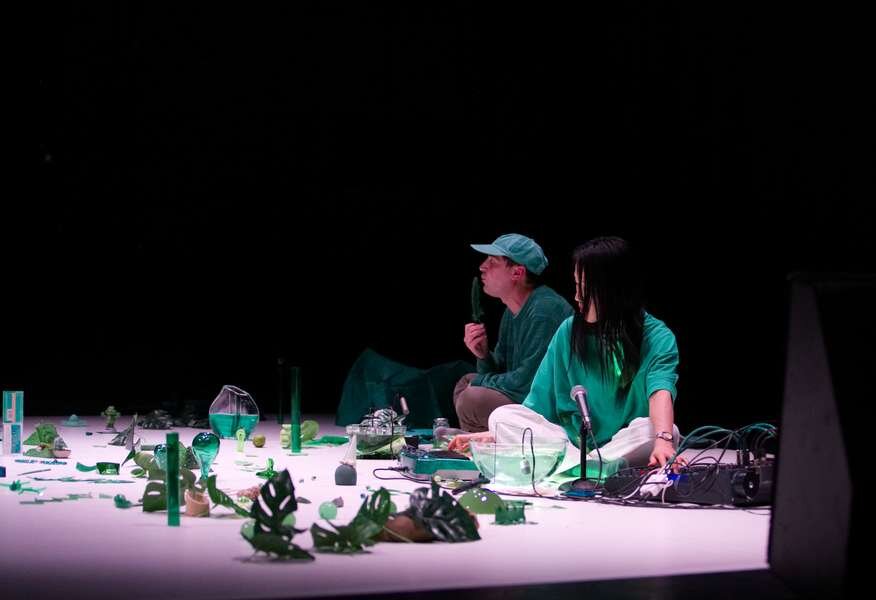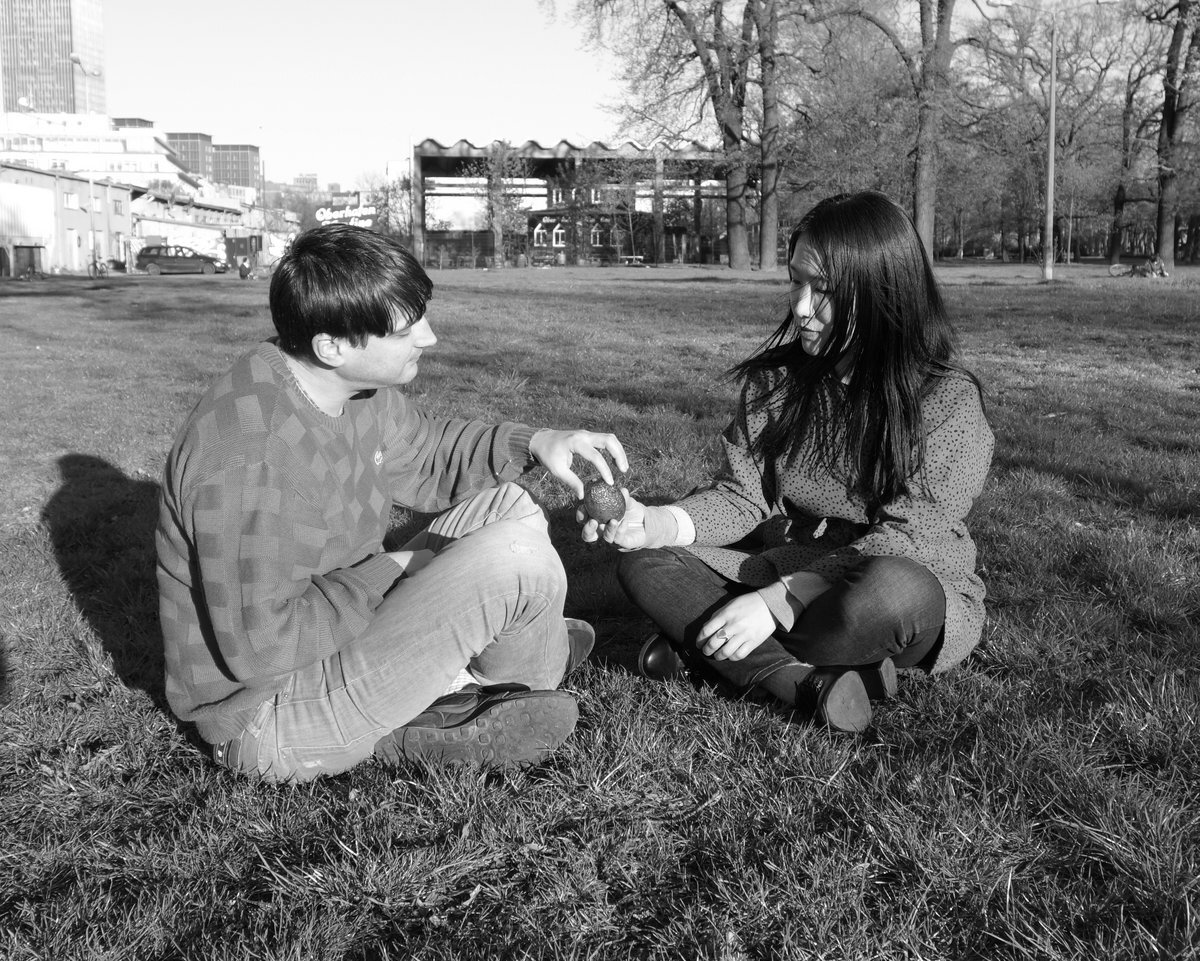Outer Sounds 011 - September 2021
The selection for September 2021 is Francesco Cavaliere & Tomoko Sauvage Viridescens on Marionette.
Email interview with Tomoko Sauvage & Francesco Cavaliere conducted during August 2021:
Outer Sounds: Where are you both located? How did you both get your start with music / sound? Tell me a little bit about your background / history / musical life.
Tomoko Sauvage: I’ve been based in Paris since 2003. I was born and grew up in Yokohama, Japan. I had classical piano lessons as a child. I got very much into jazz and American black music when when I was a teenager and started to study jazz. Since around 2006, I’ve been experimenting with bowls, water and hydrophones and have been touring and composing music with this instrument.
Francesco Cavaliere: At the moment I'm in Bruxelles but I'm based in Torino, Italy. Actually, I still have part of my sound studio in Berlin. I moved away from the city right before the arrival of Covid-19. I personally started with music very very young. My father was a prog-drummer, my grandmother a piano teacher and all the parents of my best friends were record collectors, so even when I was very young music was a big factor. We were imagining fake music bands, costumes and stuff. At 7 years old like a game and 13 years old starting to rent out my first real rehearsal room in Volterra, “Chiarugi” Tuscany. I studied music at the University of Bologna.
OS: How did the two of you meet? How did this collaboration come together?
TS: We got to know each other in the context of Berlin experimental music scene in the mid 2000’s. In 2010, Francesco invited me to do a show in a series of exhibitions and listening sessions he was curating with Marcel Türkowsky at Grimmuseum in Berlin. Although I had never done it before, Francesco encouraged me to do an exhibition for a week, and I produced a sound installation with melting ice blocks for the first time. It was quite amazing to work with him and this experience left me with a very strong impression. By the way, these events curated by Francesco and Marcel, “Whistle, Minotaure!” were really excellent and visionary. Working together as two musicians happened much later around 2016.
FC: We met in Berlin, I invited Tomoko to take part in a “sound art” program called Whistle Minotaure! a program curated together with Marcel Türkowsky at Grimmuseum, Berlin Kreuzberg. There we actually arranged Tomoko’s first ice installation.
OS: Tomoko, Most all of your work up until now has been solo, How is it to collaborate with someone else? Does that change your approach? What other sonic textures does it add to your music?
TS: I actually played everything I couldn’t include in my solo work, playing with microphones inside and outside water with different objects and voice, but also playing keyboards again. I also let Francesco play my water bowls, he had a nice idea of tapping an amplified bowl of water with a big leaf. Even though we don’t live in the same city, we took time to develop our ideas and found a common place to put them together, which wasn’t obvious at first. I think we took most out of this opportunity to fight with our own egos and to learn from each other.
OS: Tomoko, How did you come to work with amplified objects and water? John Cage’s compositions Inlets & Branches, Christian Wolff’s Stones, Alvin Lucier’s resonant vessels and Jeph Jerman’s prolific output come to mind. These works all have an animistic spirit that draws sound out of natural and everyday objects.
TS: I moved to Paris in 2003 for a personal reason and started to search for my own voice via Indian music after listening to Alice Coltrane and Terry Riley, etc. That’s how I discovered jalatharangam, the traditional Carnatic music instrument with bowls filled with water. I transformed it into an electro-acoustic instrument, water bowls, by using hydrophones & underwater microphones. I had no academic background related to sound art or electro-acoustic music before. I was really intrigued by the special timbre created by moving water when I heard jalatharangam (played by Aanayampatti Genevan at his concert in Paris) and I felt like experimenting with it. It’s after many years of experimentation that I learned a good control over hydrophonic feedback techniques and singing bubbles emitted from porous terracotta.
FC: By the way, I love Jeph Jerman and his Animist Orchestra. Once with a friend of mine, he was directly in contact with Jeph. We listened to private recordings of his ants moving on a datura plant…
OS: There is an important visual and sculptural element to your work. Is live performance necessary to portray this? Do you feel the sounds evoke the visual elements adequately on their own? Or maybe it retains more of a mysterious character? What’s the best way to convey the visual and other sensual information to the listeners?
TS: To me, a record is a record and a performance is a performance. This record is not a pure documentation of our performances. There are a lot of studio manipulations and we created a sonic space in the record which is a mixture of hand-crafted actions in real physical spaces and more abstract inner space. I absolutely visualize in my mind these gestures, objects and spaces when listening to this record but I don’t know if it’s the case for listeners.
FC: I personally believe sculptures, even the classical ones, aren’t mute. But are talking to us moving and are actually alive. So when we use objects which even aren’t strictly music related, they are indeed musical, at least mentally.
OS: Tell me more about the Henning Christensen score “Green Music” you were trying to locate & perform. How did this piece or his music inspire you?
TS: We were in contact with Thorbjørn Christiansen, Henning Christiansen’s son, to get the score of Green Music. He, instead of telling us that it didn’t really exist, kindly sent us a great book that he assembled of his father’s work, as well as other materials. We understood that Christiansen’s act of colouring his instruments green and his ears (as well as his family members) was to attract or catch the sound that has the power of nature, like a green talisman for music.
OS: What is the significance of the color green on this album? Is it mostly used as a mood, vibe, or synaesthetic quality? Tell me about the title “Viridescens”.
TS: I understand the word Viridescens as “becoming green”, it’s about process and transformation. Every time we played this performance, people came to talk to us about green. We were collecting myths, stories and superstitions about this color without doing any research. We were also incorporating found objects and sound to our performances just because they were green (for example we were recording the signal sound of traffic lights in Hong Kong), that was creating some random but unique selection of sound and musical stories. So, in a way, the color green was the vehicle that conducted us.
OS: How did you construct this album? What sound sources and materials were used to make the music? How were electronic sources and processing used to transform the sounds? Tomoko’s work has primarily been amplified acoustic objects / sounds up to now. How did you work out the blend between your two sonic worlds?
TS: I always used electronics on amplified acoustic objects. In this album, there is more of it. I also played electric or digital keyboards. Francesco did a lot of sonic sorcery using live analog and electroacoustic manipulations on pre-recorded materials, some of which were composed by the two of us. We also worked a lot on digital collage compositions while mixing together by sending files. So the process has many layers.
OS: Have you heard about Jaltatarang? It’s an Indian instrument of tuned porcelain bowls which they use to play/improvise a raga. Some of the chiming bowls / resonant sounds on this album remind me of that music.
TS: Yes, of course. See answer number 4!
OS: Francesco, your music reminds me of Nobukazu Takemura’s music and his Childisc label. Also Paul Lansky, Jon Appleton, Franco Battiato, Claudio Rocchi, Luc Ferrari and others come to mind. It is like some playful & innocent electro-acoustic stories. How did you approach this collaboration? What did you bring to it from your own music?
FC: Well I love Battiato and I know Claudio Rocchi very well, mostly his Suoni di Frontiera. Takemura and Ferrari’s music as well. Coming together with this project, I was attentive to create more space and time to listen to any musical gesture. The attention to details changed here. Normally I let everything go just after I reorganize my sounds with a long post production studio session. Tomoko is different. In my mind, I was imagining some sort of “perfect jams”, tiny music compositions. We wrote a lot of graphical scores for our live shows. Notes to remember parts, melodies, gestures, and poetry. More than anything else, I brought my research with fragile materials, sand, plants, objects, tape and computer manipulation and of course my obsession of collecting objects.
OS: How did you come to work with Ali and his Marionette Label?
FC: Ali wrote to me some time ago, he was very into releasing some of my music. At that time Viridescens was almost ready so i thought it would be a good idea to send it to Ali. The rest is now history…









